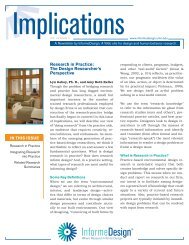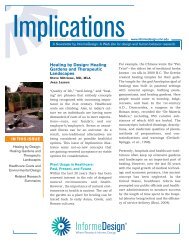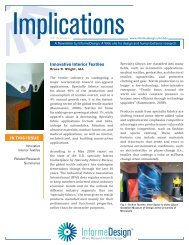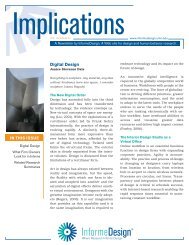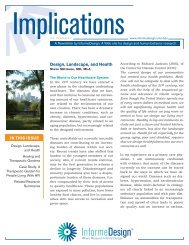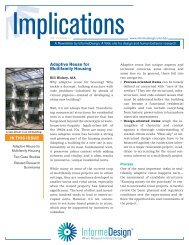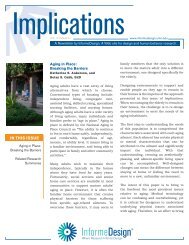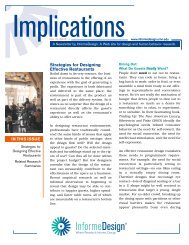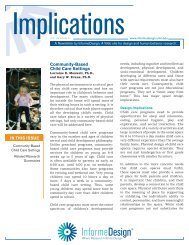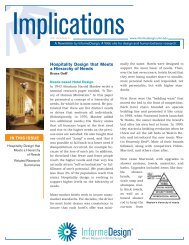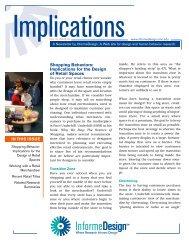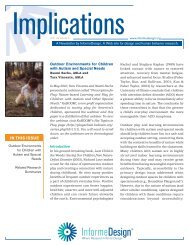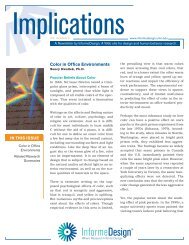Designing Spaces for Active Learning: Vol. 7, Issue - InformeDesign
Designing Spaces for Active Learning: Vol. 7, Issue - InformeDesign
Designing Spaces for Active Learning: Vol. 7, Issue - InformeDesign
Create successful ePaper yourself
Turn your PDF publications into a flip-book with our unique Google optimized e-Paper software.
Implications<br />
VOL. 07 ISSUE 01<br />
IN THIS ISSUE<br />
<strong>Designing</strong> <strong>Spaces</strong> <strong>for</strong><br />
<strong>Active</strong> <strong>Learning</strong><br />
Related Research<br />
Summaries<br />
www.in<strong>for</strong>medesign.umn.edu<br />
A Newsletter by In<strong>for</strong>meDesign. A Web site <strong>for</strong> design and human behavior research.<br />
<strong>Designing</strong> <strong>Spaces</strong> <strong>for</strong><br />
<strong>Active</strong> <strong>Learning</strong><br />
Aimee Whiteside, Ph.D.<br />
and Steve Fitzgerald<br />
Existing literature on learning spaces<br />
suggests design features impact teaching<br />
and learning (Brown & Long, 2006; Chism<br />
& Bick<strong>for</strong>d, 2002; Chism, 2006; Lomas &<br />
Oblinger, 2006; Oblinger, 2006). However,<br />
few if any research studies support this<br />
assertion with actual evidence.<br />
To help close the knowledge gap, a team<br />
of research experts, tenured faculty<br />
members, and undergraduate researchers<br />
at the University of Minnesota set out to<br />
explore relationships among <strong>for</strong>mal and<br />
in<strong>for</strong>mal learning spaces, teaching and<br />
learning practices, and student learning<br />
outcomes in an Archibald G. Bush funded<br />
pilot study in the fall of 2008. The goal<br />
was to develop evidence-based criteria<br />
<strong>for</strong> student-centered, integrated, active<br />
learning spaces using flexible design and<br />
an innovative use of technology tools.<br />
<strong>Learning</strong> <strong>Spaces</strong> Research Model<br />
Three research teams were included in<br />
this exploratory study. The study was<br />
comprised of one faculty member teaching<br />
the course, one research expert from the<br />
Office of In<strong>for</strong>mation Technology (OIT),<br />
and one or more undergraduate student<br />
researchers trained to conduct <strong>for</strong>mal<br />
research, including interviews and class<br />
observation. This approach was chosen<br />
because of the University’s interest in<br />
involving undergraduates in the research<br />
process. Recent success involving<br />
undergraduates in research has been<br />
reported by the University of Rochester<br />
(Gibbons & Foster, 2007), Carleton College<br />
(Nixon, <strong>for</strong>thcoming), and the Carnegie<br />
Foundation’s Advancement of Teaching<br />
and <strong>Learning</strong>’s “Student Voice in the<br />
Scholarship of Teaching and <strong>Learning</strong>”<br />
program.<br />
Research Methods<br />
The Study’s Primary Question was<br />
“To what extent, if any, do <strong>for</strong>mal<br />
and in<strong>for</strong>mal learning environments<br />
shape teaching and learning practices<br />
and student learning outcomes?”<br />
Sub-questions were as follows:<br />
• What is the relationship, if any, between<br />
<strong>for</strong>mal learning spaces and student<br />
learning outcomes?<br />
• What is the relationship, if any,<br />
between type of learning space and the<br />
teaching/learning activities employed<br />
by the instructor?<br />
• Where, when, and how do students<br />
complete their course assignments?<br />
To answer these questions, the research<br />
team applied traditional methods that<br />
included instructor interviews (be<strong>for</strong>e
Implications www.in<strong>for</strong>medesign.umn.edu<br />
and after the course), student focus groups <strong>for</strong> each<br />
course, and a minimum of 15 class observations<br />
using a collaboratively-designed classroom<br />
observation <strong>for</strong>m. Consistent, open communication<br />
was essential to managing the copious research and<br />
curricular issues that emerged. Biweekly research<br />
team meetings proved to be vitally important.<br />
Student assignment logs and student photo surveys<br />
were introduced as it became evident that more<br />
innovative research methods were needed to provide<br />
descriptive answers to the research questions.<br />
Assignment logs provided individualized, learningspecific<br />
details about the environment in which<br />
students completed their coursework, including<br />
exposure to food and drink, use of technology and<br />
multimedia, noise level, and the amount of people<br />
working with and around them. Photo surveys<br />
supported a visually-rich understanding of students’<br />
use of <strong>for</strong>mal and in<strong>for</strong>mal learning spaces.<br />
Features of <strong>Active</strong> <strong>Learning</strong> Classrooms<br />
The Office of Classroom Management (OCM)<br />
constructed two pilot project, general purpose<br />
classrooms that were designed as student-centered,<br />
flexible, active learning spaces. The project was<br />
intended to stimulate interest in innovative classroom<br />
design, to demonstrate flexible classroom construction<br />
techniques, and to allow assessment of learning<br />
outcomes. OCM partnered with the OIT Digital Media<br />
Center <strong>for</strong> this research-based assessment.<br />
Pilot spaces were general purpose classroom<br />
renovations designed to support active engagement<br />
of both instructors and students. Classrooms<br />
were labeled <strong>Active</strong> <strong>Learning</strong> Classrooms (ALCs)<br />
and provided switchable laptop-based technology,<br />
multiple fixed-panel display/projection systems, and<br />
an instructor station that allowed display of specific<br />
in<strong>for</strong>mation. Each space featured reconfigurable,<br />
low-profile flooring with internal power and cable<br />
management to accommodate technology devices.<br />
Where Research In<strong>for</strong>ms Design®<br />
Demountable wall systems allowed the rooms to<br />
be reconfigured, saving renovation costs over the<br />
life cycle of the building. ALCs could be “flexed” on<br />
an annual basis to meet changing rooms sizes or<br />
pedagogical (i.e., teaching) requirements. The largest<br />
space (117 at capacity) was divisible into two ALCs (72<br />
and 36 capacity), two traditional seating table/chair<br />
classrooms, or one ALC and one traditional classroom.<br />
Key to the experience were the round tables that seat<br />
9 students each, which enabled students to work in<br />
small groups. A 360-degree, glass-surface marker<br />
board around the circumference of the classroom and<br />
document camera were also included (see fig. 1).<br />
Fig. 1: ALCs are designed to foster an interactive, student centered<br />
learning experience.<br />
Classroom Case Studies<br />
Three case study courses were selected based on<br />
faculty interest in the scholarship of teaching and<br />
learning, classroom location, course discipline, and<br />
class size. Due to differences across the courses<br />
selected, a variety of teaching and learning strategies<br />
were employed. Pilot learning spaces allowed faculty<br />
and students to experience and assess the impact<br />
of new classroom designs on teaching and learning<br />
practices. The following table provides details of the<br />
courses, research team, classroom technology, and<br />
layouts (Fig. 2 next page).<br />
2
Implications www.in<strong>for</strong>medesign.umn.edu<br />
Course In<strong>for</strong>mation<br />
Family Social Science:<br />
Personal and Family<br />
Finances<br />
117 students<br />
Instructor:<br />
Catherine Solheim<br />
Student Researcher:<br />
Kevin Race<br />
Research Fellow:<br />
Aimee Whiteside<br />
Post-Secondary Teaching<br />
and <strong>Learning</strong>: Principles<br />
of Biological Sciences<br />
37-45 students<br />
Instructor:<br />
Jay Hatch<br />
Student Researchers:<br />
Lexi Schmidt and<br />
Tabinda Hasan<br />
Research Fellow:<br />
D. Christopher Brooks<br />
Writing: Technical and<br />
Professional Writing<br />
22 students<br />
Instructor:<br />
Lee-Ann Breuch<br />
Student Researcher:<br />
Tim Quan<br />
Research Fellow:<br />
Aimee Whiteside<br />
About the Space<br />
Layout A. Explored the relationship,<br />
if any, between learning spaces in a<br />
large-enrollment course. The ALC was<br />
a “smart,” technology-rich classroom<br />
featuring dual projection capabilities,<br />
large LCD student display screens, and<br />
glass markerboards around the perimeter<br />
of the classroom. This research situation<br />
allowed the course research team to<br />
develop and test a number of hypotheses,<br />
such as: Students learning in ALCs<br />
accomplish Student <strong>Learning</strong> Outcomes<br />
(SLOs) at higher rates than students<br />
learning in traditional classrooms.<br />
Layout B. Used a quasi-experimental<br />
comparison between a traditional learning<br />
space and another ALC (seats 45). This<br />
classroom setting allowed the research<br />
team to develop and test a number of<br />
hypotheses, such as: Students learning<br />
in ALCs accomplish Student <strong>Learning</strong><br />
Outcomes (SLOs) at higher rates than<br />
students learning in traditional classrooms.<br />
Layout C. Explored the relationship,<br />
if any, between learning spaces <strong>for</strong> a<br />
writing course. The learning space <strong>for</strong><br />
this case study emerged from a 2008<br />
partnership between the Office of<br />
In<strong>for</strong>mation Technology (OIT) and the<br />
College of Liberal Arts (CLA).<br />
Fig. 2: Details of the three case study courses including course in<strong>for</strong>mation, methods, and classroom layouts.<br />
Where Research In<strong>for</strong>ms Design®<br />
Classroom Layouts A-C<br />
3
Implications www.in<strong>for</strong>medesign.umn.edu<br />
Instructor and Student Outcomes<br />
Data from a related study conducted in September<br />
2007 to May 2008 by the ALC Pilot Evaluation<br />
Team suggested that the ALCs yielded very positive<br />
responses from instructors and students. Instructors<br />
found their overall relationships with their students<br />
had deepened, they felt closer to their students.<br />
Students surveyed found the ALCs made them feel<br />
more connected, particularly with their classmates,<br />
and they noted the positive effects of this learning<br />
space on their collaborative projects.<br />
Although the final analysis from this Fall 2008<br />
Bush Grant-funded exploratory study derived from<br />
questionnaire data, interviews, class observations,<br />
focus groups, student assignment logs, and photo<br />
surveys will not be complete until Summer 2009, the data<br />
does suggest the following preliminary implications:<br />
• Round tables inherently created a collaborative<br />
environment <strong>for</strong> learning and, in most cases, allowed<br />
students to quickly and easily create a community<br />
of learners. Round tables <strong>for</strong>ced students to look at<br />
each other, thus changing the relationship. Round<br />
tables were key to the experience in the ALC.<br />
• Students and instructors had different views on<br />
room layout and design. In one case of a very<br />
large open <strong>for</strong>mal learning space, students in the<br />
focus group reported that they enjoyed the open<br />
space. These students reported that this space<br />
made them feel closer to their instructor than they<br />
would have in a more traditional classroom. The<br />
instructor in that same space felt overwhelmed by<br />
the openness and size of the space and preferred<br />
the control that a smaller.<br />
• Furniture layout was found beneficial <strong>for</strong><br />
small group discussions. As instructors posed a<br />
discussion question to the class, students could<br />
discuss the problem separately at their tables,<br />
and then write ideas on the markerboards placed<br />
around the classroom. It was easy to participate,<br />
compared<br />
Where Research In<strong>for</strong>ms Design®<br />
Fig. 3: Students find better collaboration with use of round tables.<br />
to traditional classrooms where students are<br />
arranged in a grid <strong>for</strong>mation.<br />
• Com<strong>for</strong>t and convenience features including the<br />
availability of food and drink, wireless connectivity,<br />
and lighting. Aesthetics, flexibility, and com<strong>for</strong>t<br />
provided by the furniture and the space were<br />
central concerns <strong>for</strong> students.<br />
• Students and instructors were divided in their<br />
views regarding the availability and access to<br />
technology. When laptop computers with wireless<br />
connectivity were available in the classroom, many<br />
students came to class earlier and stayed later.<br />
Student focus group participants reported that<br />
availability of technology in their learning space<br />
elevated their learning experience and helped<br />
them to become more efficient, effective citizens.<br />
The instructor, on the other hand, saw students’<br />
use of technology during class as disrespectful<br />
and disruptive to learning. This instructor also<br />
reported that students were noticeably less<br />
com<strong>for</strong>table when technology tools were removed<br />
from the learning space.<br />
• Glass markerboards that helped students<br />
collaborate with their teams received favorable<br />
responses. One instructor noted reflections<br />
4
Implications www.in<strong>for</strong>medesign.umn.edu<br />
from the glass markerboard to be problematic.<br />
Instructors found document cameras and student<br />
display screens to be the most important features.<br />
Future Research on <strong>Learning</strong> <strong>Spaces</strong><br />
The University of Minnesota findings provide a starting<br />
point not only <strong>for</strong> designers, but also further research<br />
on learning-supportive spaces. The following are<br />
recommendations <strong>for</strong> future research:<br />
1. Select faculty members who are invested in<br />
learning space research and the scholarship of<br />
teaching and learning. Carefully select faculty<br />
members who have participated in different faculty<br />
development programs related to technology.<br />
2. Form research teams with faculty members,<br />
research experts, and student researchers.<br />
Partnering trained student researchers with<br />
faculty members and research experts in a<br />
research team will allow the use of more productive<br />
research instruments and methods, keep the<br />
project on task, and maintain better in<strong>for</strong>mation<br />
about the curricula and teaching strategies.<br />
3. Involve undergraduates as partners in the<br />
research process. As students themselves,<br />
student researchers inherently understand<br />
the student audience. They see things that<br />
researchers, faculty members, administrators,<br />
and other experts might miss.<br />
4. Supplement traditional research methods<br />
with innovative tools. New approaches such as<br />
student logs and learning space photo surveys<br />
may provide data that better and more completly<br />
answer researchers’ questions, leading to<br />
evidence-based solutions.<br />
References<br />
—Brown, M., & Long, P. (2006). Trends in learning<br />
space design. In D. Oblinger, (Ed.), <strong>Learning</strong> <strong>Spaces</strong>.<br />
EDUCAUSE. Retrieved December 1, 2007, from http://<br />
www.educause.edu/ir/library/pdf/pub7102.pdf.<br />
—Chism, N. (2006). Challenging traditional<br />
assumptions and rethinking learning spaces. In<br />
Where Research In<strong>for</strong>ms Design®<br />
D. Oblinger (Ed.), <strong>Learning</strong> <strong>Spaces</strong>. EDUCAUSE.<br />
Retrieved December 1, 2007, from http://www.<br />
educause.edu/ir/library/pdf/pub7102.pdf.<br />
—Chism, N., & Bick<strong>for</strong>d, D. (Eds.). (2002). The<br />
importance of physical space in creating supportive<br />
learning environments. New Directions <strong>for</strong> Teaching<br />
and <strong>Learning</strong>, 92, 91-97.<br />
—Foster, N., & Gibbons, S. (2007). Studying<br />
Students: The undergraduate research project at<br />
the University of Rochester. Chicago: Association of<br />
College and Research Libraries. Retrieved August 11,<br />
2008, from http://www.ala.org/ala/acrl/acrlpubs/<br />
downloadables/Foster-Gibbons_cmpd.pdf.<br />
—Lomas, M., & Oblinger, D. (2006). Student practices<br />
and their impact on learning spaces. In D. Oblinger<br />
(Ed.), <strong>Learning</strong> spaces. EDUCAUSE. retrieved from<br />
http://net.educause.edu/ir/library/pdf/PUB7102b.<br />
pdf.<br />
—Oblinger, D. (2006). Space as a change agent. In<br />
, D. Oblinger (Ed.), <strong>Learning</strong> <strong>Spaces</strong>. EDUCAUSE.<br />
Retrieved from the Internet on December 1, 2007 at<br />
http://www.educause.edu/ir/library/pdf/pub7102.<br />
pdf.<br />
—University of Minnesota <strong>Active</strong> <strong>Learning</strong> Classrooms<br />
Pilot Evaluation Team. (2008). <strong>Active</strong> learning<br />
classrooms pilot evaluation: Fall 2007 findings and<br />
recommendations. University of Minnesota. Retrieved<br />
October 8, 2008, from<br />
http://dmc.umn.edu/activelearningclassrooms/<br />
alc2007.pdf.<br />
Additional Resources<br />
—Brown, M., & Lippincott, J. (2003). <strong>Learning</strong> spaces:<br />
More than meets the eye. EDUCAUSE Quarterly 1.<br />
Retrieved December 7, 2007, from http://www-cdn.<br />
educause.edu/ir/library/pdf/PUB7102.pdf.<br />
—EDUCAUSE <strong>Learning</strong> Space Design Constituent<br />
Group. Retrieved from http://www.educause.edu/<br />
<strong>Learning</strong>SpaceDesignConstituentGroup/5983.<br />
—Milne, A. (2006). <strong>Designing</strong> blended learning<br />
space to the student experience. In D. Oblinger (Ed.),<br />
<strong>Learning</strong> <strong>Spaces</strong>. EDUCAUSE.<br />
5
Implications www.in<strong>for</strong>medesign.umn.edu<br />
Retrieved from http://net.educause.edu/ir/library/<br />
pdf/PUB7102k.pdf.<br />
—Montgomery, T. (2008). Space matters: Experiences<br />
of managing static <strong>for</strong>mal learning spaces. <strong>Active</strong><br />
<strong>Learning</strong> in Higher Education, 9, 122-138<br />
—Oblinger, D. (2003). Boomers, Gen-Xers, and<br />
Millennials: Understanding the ‘new students’.<br />
EDUCAUSE Review 38(4), 37–47. Retrieved from<br />
http://www.educause.edu/ir/library/pdf/erm0342.<br />
pdf.<br />
—Oblinger, D., & Oblinger, J. (2005). Is it age or IT:<br />
First steps toward understanding the net generation.<br />
In D. Oblinger and J. Oblinger. Educating the Net<br />
Generation. EDUCAUSE. Retrieved December 1,<br />
2007, from http://www.educause.edu/ir/library/pdf/<br />
pub7101.pdf.<br />
—University of Minnesota Office of Classroom<br />
Management. (2008). U of M <strong>Active</strong> <strong>Learning</strong><br />
General Purpose Classroom Initiative. University of<br />
Minnesota. Retrieved from http://www.classroom.<br />
umn.edu/active-learn-room.asp.<br />
About the Authors<br />
Aimee L. Whiteside, Ph.D.,<br />
received her doctoral degree<br />
in rhetoric and scientific and<br />
technical communication from the<br />
University of Minnesota in 2007.<br />
She is currently a Research Fellow<br />
in the Digital Media Center, Office<br />
of In<strong>for</strong>mation Technology at the<br />
University of Minnesota, Twin<br />
Cities.<br />
Creator: Founding Sponsor:<br />
© 2002, 2005 by the Regents of the University of Minnesota.<br />
Steve Fitzgerald is the Director of the<br />
Office of Classroom Management at<br />
the University of Minnesota. This<br />
unique organization in Academic<br />
Support Resources is accountable<br />
<strong>for</strong> all central classroom issues in<br />
55 academic buildings in three<br />
Twin Cities campus locations.<br />
Related Research Summaries<br />
In<strong>for</strong>meDesign has many Research Summaries about<br />
learning environments, and other, pertinent, related<br />
topics. This knowledge will be valuable to you as you<br />
consider your next design solution.<br />
“Personal Boundaries and Classroom Seating”<br />
—Environment and Behavior<br />
“Classroom Layout Preference Reflects Teaching<br />
Style”<br />
—Educational Studies<br />
“Supportive Elements Enhance Classroom <strong>Learning</strong>”<br />
—Ergonomics<br />
“Obstructions and Light Loss in Rooms”<br />
—Lighting Research & Technology<br />
Images Courtesy of:<br />
Nick Rosencrans (header photo)<br />
Office of Classroom Management (Figs.1, 2a, 2b & 3)<br />
Peter Oberg (Fig. 2c)<br />
Jeff Whiteside (author photo)<br />
The Mission<br />
The Mission of In<strong>for</strong>meDesign is to facilitate designers’<br />
use of current, research-based in<strong>for</strong>mation as a decisionmaking<br />
tool in the design process, thereby<br />
integrating research and practice.<br />
6



